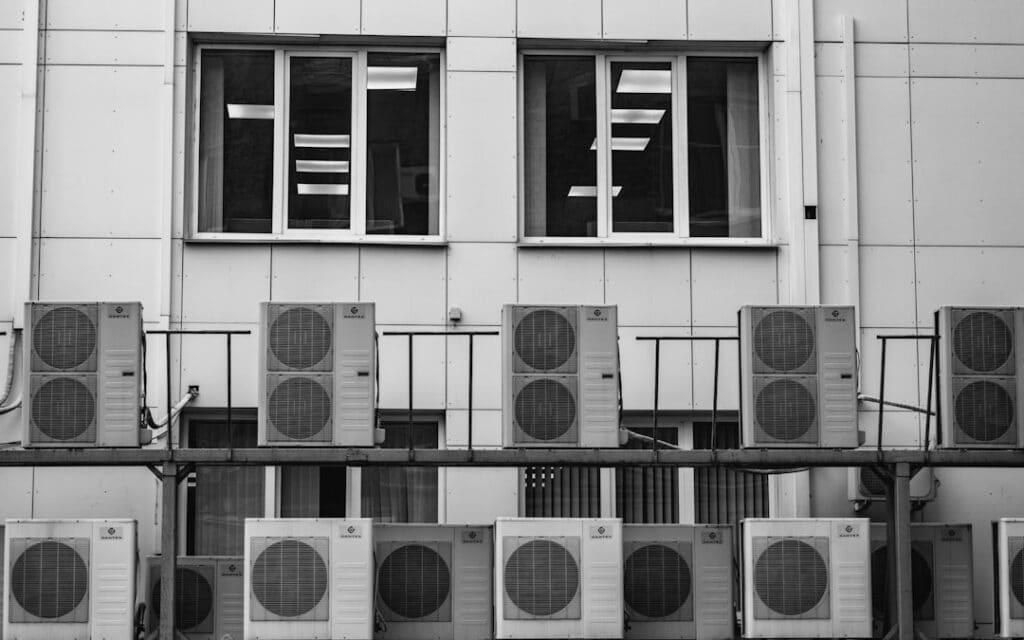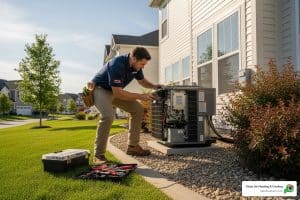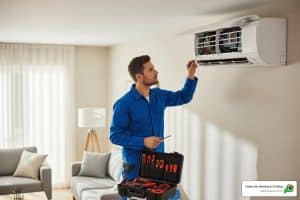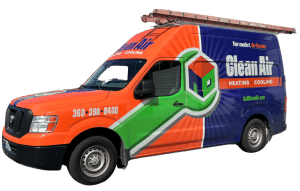Air conditioner rebate programs are a fantastic way to make upgrading your home’s cooling system more affordable and energy-efficient. These rebates can help homeowners save money upfront and reduce long-term energy costs. Understanding the key benefits can help you make informed decisions that not only improve comfort but also significantly lower your utility bills.
- Overview: Rebates provide financial incentives for purchasing energy-efficient air conditioner units.
- Importance of Rebates: Designed to encourage smart energy use and lower overall power consumption.
- Energy Savings: Reduce your energy bills with efficient HVAC systems that offer better cooling at lower costs.
I’m Colin Matei, and as the Owner and President of Clean Air Heating & Cooling, I’ve dedicated my career to helping homeowners understand how they can maximize savings through programs like the air conditioner rebate. With a focus on excellent service and energy efficiency, my team’s expertise ensures you’re equipped to steer rebates effectively. Keep reading to find how these programs can transform your home’s energy efficiency.

Key terms for air conditioner rebate:
– AC rebates
– HVAC deals
– PSE rebates
Understanding Air Conditioner Rebates
Navigating air conditioner rebates can seem daunting, but breaking it down into simple parts makes it easier to understand—and more importantly, to save money. Let’s explore the types of rebates available and how federal tax credits can add to your savings.
Types of Rebates Available
Rebate programs are essentially financial incentives that encourage homeowners to purchase energy-efficient air conditioners. These programs can vary widely, but they generally fall into three main categories:
- Instant Discounts: These are immediate price reductions at the point of sale. When you buy an eligible energy-efficient unit, you pay less upfront. It’s like getting a discount coupon for your new air conditioner right at the checkout.
- Cash-Back Offers: After purchasing and installing your new system, you can apply for a cash-back rebate. This means you’ll receive a check in the mail or a direct deposit after submitting proof of purchase and installation.
- Financing Options: Some programs offer low-interest loans or other financing options to make it easier to afford the initial cost of a new, efficient system. This can be especially helpful if you’re looking to spread out payments over time.

Federal Tax Credits
Federal tax credits are another way to save big on your air conditioning upgrade. Thanks to the Inflation Reduction Act, homeowners can claim a tax credit for purchasing and installing energy-efficient air conditioners. Here’s how it works:
- 30% Tax Credit: You can claim 30% of the total project cost as a tax credit. This means if your project costs $2,000, you could reduce your tax bill by $600.
- $600 Maximum: While the credit is 30% of the project cost, there is a maximum limit of $600 for central air conditioners.
To claim this credit, you’ll need to complete IRS Form 5695 when you file your taxes. Make sure your new air conditioner meets the eligibility criteria, such as specific efficiency ratings, to qualify.
These federal tax credits and rebate programs are designed to make energy-efficient upgrades more accessible. They not only help reduce the initial cost but also lead to long-term savings on energy bills. By understanding these options, you can make the most of your investment and contribute to a greener environment.
State and Local Rebates
When it comes to saving on air conditioning, state and local rebates can make a significant difference. These programs are designed to encourage the adoption of energy-efficient systems, offering financial incentives that can reduce your upfront costs.
Michigan AC Rebate for 2024
In Michigan, the push for energy efficiency is strong, and local utility companies play a vital role. They offer rebates to residents who invest in energy-efficient air conditioning systems. For 2024, the rebates can go up to $6,000 for heat pumps and up to $1,000 for energy-efficient AC systems.
These rebates are part of a broader effort to reduce energy consumption and promote sustainable living. By upgrading to a more efficient system, not only do you save on your energy bills, but you also help Michigan meet its environmental goals.
Ohio Energy Efficiency Rebates
Ohio also offers substantial incentives through its energy efficiency rebate programs. The Home Efficiency Rebates (HOMES) program is particularly notable, providing up to $14,000 per household. This includes up to $8,000 for heat pump costs, $1,750 for a heat pump water heater, and $4,000 for panel/service upgrades.
These rebates are designed to make it easier for homeowners to transition to energy-efficient systems, ultimately lowering energy bills and reducing environmental impact. By taking advantage of these rebates, Ohio residents can make significant improvements to their homes with less financial strain.
In both Michigan and Ohio, utility companies are key players in these rebate programs. They work alongside state agencies to offer these incentives, making energy-efficient upgrades more accessible to homeowners.
By exploring these state and local rebates, you can open up significant savings on your next air conditioning upgrade. Plus, you’ll be contributing to a more sustainable future.
Maximizing Your Savings
Combining Federal and State Rebates
When it comes to maximizing your savings on air conditioning upgrades, combining federal and state rebates can be a game-changer. The Federal Government offers a 30% tax credit on qualifying energy-efficient improvements, with a cap of $600 for central air conditioners. This credit can be claimed using IRS Form 5695.
But here’s where it gets interesting: you can stack these federal credits with state and local rebates to further reduce your costs. For instance, if you’re in California, you can combine the federal tax credit with state rebates that offer up to $1,000 for energy-efficient AC systems. This means more money stays in your pocket while you invest in a system that lowers your energy bills.
There are annual aggregate limits on these credits. The total cap is $3,200 per year, which includes a $1,200 limit for home envelope improvements like insulation and windows, and $2,000 for heat pumps and biomass stoves/boilers.

Timing Your Purchases
Timing is everything when it comes to air conditioner rebates. To maximize your savings, consider spreading your energy-efficient upgrades over several years. This allows you to fully use the annual limits on tax credits and rebates without exceeding them.
For example, if you’re planning to install a heat pump, you might also want to invest in attic insulation in the same year. This way, you can claim up to $1,200 in tax credits for the insulation and up to $2,000 for the heat pump. The following year, you could replace windows and doors, accessing additional credits and rebates.
Another strategy is optimizing attic insulation before upgrading your heating or cooling system. Proper insulation can reduce the size and cost of the system you need, leading to further savings.
Lastly, consider combining heat pump installations with window or door replacements. This strategic approach not only maximizes your tax credits and rebates but also improves your home’s energy efficiency, leading to long-term savings on utility bills.
By carefully planning your purchases and upgrades, you can make the most of the available incentives and enjoy a more comfortable, energy-efficient home.
How to Claim Your Rebates
Step-by-Step Guide
Claiming your air conditioner rebate might seem complicated, but with a little guidance, you can steer the process smoothly. Here’s a simple step-by-step guide to help you claim your rebates and tax credits.
- Find Eligible Products: First, ensure your air conditioner is eligible for rebates. Look for ENERGY STAR-certified models, as these are commonly required for both federal and state rebates. The ENERGY STAR Rebate Finder is a helpful tool to identify qualifying products.
- Complete Rebate Applications: Once you’ve purchased an eligible product, you’ll need to fill out a rebate application. This often involves providing details about the product, purchase date, and installation.
- Submit IRS Form 5695: To claim federal tax credits, you’ll need to complete IRS Form 5695. This form is used to calculate and claim the tax credit for energy-efficient home improvements. Make sure you have all necessary documentation, such as receipts and product specifications, to fill out the form accurately.
- Gather Required Documentation: Collect all required documents, including a paid-in-full itemized invoice or receipt, the AHRI reference number, and model/unit numbers. These documents prove your purchase and installation of eligible products.
- Meet Deadlines: Submit your applications and forms by the specified deadlines. Missing a deadline could mean missing out on valuable rebates and credits.
By following these steps, you can successfully claim your rebates and enjoy the financial benefits of your energy-efficient upgrades.
Common Mistakes to Avoid
When applying for air conditioner rebates, make sure to avoid these common pitfalls:
- Missing Deadlines: Each rebate program has its own deadline. Failing to submit your application on time can result in losing the rebate.
- Incomplete Applications: Ensure all sections of your rebate application and IRS Form 5695 are complete. Missing information can delay processing or cause your application to be rejected.
- Not Meeting Eligibility Criteria: Double-check that your air conditioner meets the eligibility requirements, such as being ENERGY STAR-certified. Installing a non-qualifying unit will disqualify you from receiving rebates.
By being aware of these common mistakes, you can streamline the rebate process and maximize your savings on your air conditioning upgrade.
Frequently Asked Questions about Air Conditioner Rebates
Is a new AC a tax write-off?
Yes, a new air conditioner can be a tax write-off if it meets certain energy efficiency standards. The federal tax credit allows you to claim up to 30% of the project cost, with a maximum credit of $600 for central air conditioners. However, there is an annual deduction cap of $1,200 for various energy-efficient improvements, including water heaters, furnaces, boilers, and central air conditioners. The unit must be installed in your principal residence, and it should meet or exceed the energy efficiency criteria to qualify for the credit.
What appliances qualify for energy tax credit 2024?
For the 2024 tax year, several appliances and home improvements qualify for energy tax credits. These include:
- Central Air Conditioners: Must meet specific SEER2 and EER2 ratings.
- Water Heaters: Energy-efficient models, including heat pump water heaters.
- Furnaces and Boilers: High-efficiency models that reduce energy consumption.
- Exterior Doors, Windows, and Skylights: Must meet energy efficiency standards.
- Insulation Materials: Products that improve your home’s energy efficiency.
- Heat Pumps: Both air-source and geothermal models.
- Biomass Stoves and Boilers: Must meet efficiency requirements.
These credits are a great way to reduce the cost of upgrading to energy-efficient systems and materials in your home.
How can I find local rebates?
Finding local rebates for air conditioners and other energy-efficient appliances can be straightforward with a few resources:
- Utility Company Websites: Many utility companies offer rebates for energy-efficient upgrades. Check their websites for details on available programs.
- State Energy Offices: State offices often provide information on local and state-wide rebate programs. They can be a valuable resource for finding additional savings.
- ENERGY STAR Rebate Finder: This tool helps you locate rebates and incentives for ENERGY STAR-certified products in your area. It’s a convenient way to see what offers are available based on your location.
By leveraging these resources, you can uncover additional savings opportunities and make the most of your energy-efficient investments.
Conclusion
Navigating air conditioner rebates can seem overwhelming, but the potential savings make it worthwhile. Rebates not only help reduce the initial cost of installing energy-efficient systems but also contribute to long-term savings on your utility bills. Programs like the federal tax credit and various state and local rebates create a compelling incentive to upgrade your home’s cooling systems.
At Clean Air Heating & Cooling, we are committed to helping you maximize these savings. Our team provides prompt, high-quality service, ensuring that your new air conditioning system is installed correctly and efficiently. We stand by our 25% utility savings guarantee, giving you peace of mind that you’re making a smart investment for your home and the environment.
Customer satisfaction is our top priority, and it shows in our over 480 5-star Google reviews. We strive to offer the best service experience possible, from helping you steer rebate applications to ensuring your system operates at peak performance. Our focus on honesty and transparency means you can trust us to provide reliable advice and support.
For more information on how we can assist with your air conditioning needs, including heat pump installations, visit our Heat Pumps Service Page. Let us help you take advantage of the available rebates and start saving today!





